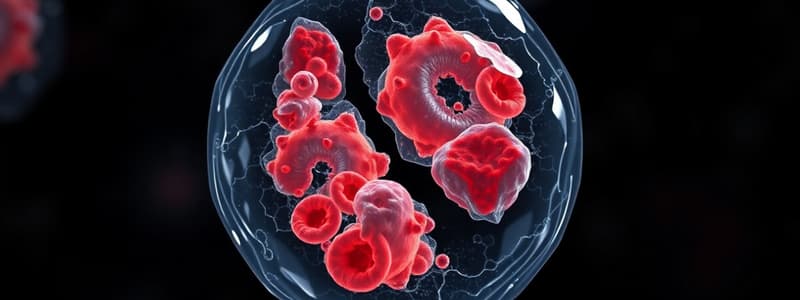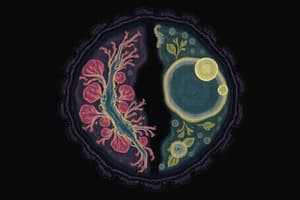Podcast
Questions and Answers
What is the primary purpose of cell division in multicellular organisms?
What is the primary purpose of cell division in multicellular organisms?
- Energy production
- Cellular respiration
- DNA replication only
- Development, growth, and repair (correct)
During which phase of the cell cycle does DNA replication occur?
During which phase of the cell cycle does DNA replication occur?
- G1 phase
- M phase
- S phase (correct)
- Cytokinesis
What is the role of the centromere in cellular division?
What is the role of the centromere in cellular division?
- It separates the daughter cells.
- It attaches sister chromatids together. (correct)
- It contains genetic material.
- It initiates mitosis.
What proportion of a cell's life span does interphase typically occupy?
What proportion of a cell's life span does interphase typically occupy?
When are chromosomes visible within the cell?
When are chromosomes visible within the cell?
Which stage of mitosis is characterized by the condensation of chromatin into visible chromosomes?
Which stage of mitosis is characterized by the condensation of chromatin into visible chromosomes?
During which stage of mitosis do chromatids split apart at the centromere?
During which stage of mitosis do chromatids split apart at the centromere?
What significant event occurs during Telophase in the mitotic process?
What significant event occurs during Telophase in the mitotic process?
In which stage of mitosis are chromosomes aligned at the cell's equatorial plane?
In which stage of mitosis are chromosomes aligned at the cell's equatorial plane?
What happens to the spindle apparatus at the end of Telophase?
What happens to the spindle apparatus at the end of Telophase?
What happens to a cell's ability to transport materials as its size increases?
What happens to a cell's ability to transport materials as its size increases?
At which stage of the cell cycle are chromosomes no longer visible?
At which stage of the cell cycle are chromosomes no longer visible?
What is a key factor limiting cell size?
What is a key factor limiting cell size?
What is one disadvantage of asexual reproduction compared to sexual reproduction?
What is one disadvantage of asexual reproduction compared to sexual reproduction?
Which phase of mitosis is characterized by the alignment of chromosomes along the cell equator?
Which phase of mitosis is characterized by the alignment of chromosomes along the cell equator?
During which specific phase does DNA replication occur in the cell cycle?
During which specific phase does DNA replication occur in the cell cycle?
What is a significant consequence of cancer cells crowding normal cells?
What is a significant consequence of cancer cells crowding normal cells?
Which of the following best describes how cancer cells differ from normal cells in their life cycle?
Which of the following best describes how cancer cells differ from normal cells in their life cycle?
What is the primary outcome of meiosis II in the process of sex chromosome inheritance?
What is the primary outcome of meiosis II in the process of sex chromosome inheritance?
During fertilization, which specific combination of chromosomes leads to the development of female offspring?
During fertilization, which specific combination of chromosomes leads to the development of female offspring?
What can contribute to the development of cancer aside from genetic factors?
What can contribute to the development of cancer aside from genetic factors?
Which statement is true regarding the structure of mitosis?
Which statement is true regarding the structure of mitosis?
What is a critical feature of the sex chromosome inheritance diagram?
What is a critical feature of the sex chromosome inheritance diagram?
In the initial stages of meiosis, how are the sex chromosomes represented?
In the initial stages of meiosis, how are the sex chromosomes represented?
What does the directional arrow in the diagram signify?
What does the directional arrow in the diagram signify?
What is the primary difference between cytokinesis in animal cells and plant cells?
What is the primary difference between cytokinesis in animal cells and plant cells?
What is the role of spindle fibers during cell division?
What is the role of spindle fibers during cell division?
Which of the following statements about nondisjunction is accurate?
Which of the following statements about nondisjunction is accurate?
What best describes the process of differentiation in cells?
What best describes the process of differentiation in cells?
Which factor is NOT associated with the formation of tumors?
Which factor is NOT associated with the formation of tumors?
What is the outcome of meiosis in terms of the number of daughter cells produced?
What is the outcome of meiosis in terms of the number of daughter cells produced?
Which stage of meiosis is primarily responsible for ensuring genetic variation?
Which stage of meiosis is primarily responsible for ensuring genetic variation?
During which phase of meiosis do sister chromatids separate?
During which phase of meiosis do sister chromatids separate?
Which of the following statements correctly describes a difference between meiosis and mitosis?
Which of the following statements correctly describes a difference between meiosis and mitosis?
What role does cytokinesis play in meiosis?
What role does cytokinesis play in meiosis?
Flashcards
Sex Chromosome Inheritance
Sex Chromosome Inheritance
The process of how X and Y chromosomes are passed from parents to offspring during meiosis and fertilization.
Meiosis I
Meiosis I
The first division in meiosis, where a cell with homologous chromosome pairs creates two daughter cells with one set of chromosomes each.
Meiosis II
Meiosis II
The second division in meiosis, where the two daughter cells created in Meiosis I divide again, creating four haploid cells.
Fertilization
Fertilization
Signup and view all the flashcards
Sex chromosomes
Sex chromosomes
Signup and view all the flashcards
Apoptosis
Apoptosis
Signup and view all the flashcards
Cell size limit
Cell size limit
Signup and view all the flashcards
Sexual reproduction advantage
Sexual reproduction advantage
Signup and view all the flashcards
Chromosome visibility
Chromosome visibility
Signup and view all the flashcards
Cell cycle order
Cell cycle order
Signup and view all the flashcards
Mitosis
Mitosis
Signup and view all the flashcards
Phases of Mitosis
Phases of Mitosis
Signup and view all the flashcards
Cytokinesis
Cytokinesis
Signup and view all the flashcards
Cancer
Cancer
Signup and view all the flashcards
Cancer Cell Growth
Cancer Cell Growth
Signup and view all the flashcards
Prophase
Prophase
Signup and view all the flashcards
Metaphase
Metaphase
Signup and view all the flashcards
Anaphase
Anaphase
Signup and view all the flashcards
Telophase
Telophase
Signup and view all the flashcards
Mitosis Stages
Mitosis Stages
Signup and view all the flashcards
Cell Division
Cell Division
Signup and view all the flashcards
M Phase
M Phase
Signup and view all the flashcards
S Phase
S Phase
Signup and view all the flashcards
Interphase
Interphase
Signup and view all the flashcards
Centromere
Centromere
Signup and view all the flashcards
Meiosis I Stages
Meiosis I Stages
Signup and view all the flashcards
Crossing Over
Crossing Over
Signup and view all the flashcards
Meiosis II Stages
Meiosis II Stages
Signup and view all the flashcards
Haploid Daughter Cells
Haploid Daughter Cells
Signup and view all the flashcards
Genetic Variation in Meiosis
Genetic Variation in Meiosis
Signup and view all the flashcards
Cytokinesis in Animal Cells
Cytokinesis in Animal Cells
Signup and view all the flashcards
Spindle Fibers' Role
Spindle Fibers' Role
Signup and view all the flashcards
Cell plate Formation
Cell plate Formation
Signup and view all the flashcards
Tumor Formation
Tumor Formation
Signup and view all the flashcards
Cell Differentiation
Cell Differentiation
Signup and view all the flashcards
Study Notes
Cell Division
- Multicellular organisms depend on cell division for development, growth, and repair
- Cell division is the process by which a cell divides into two daughter cells
M Phase
- The M phase of the cell cycle is the Cellular Division phase; it has two parts: Mitosis and Cytokinesis
S Phase
- S phase, also known as Synthesis phase is a part of interphase where DNA is replicated
Interphase
- Interphase is the stage during which the cell grows, develops into a mature functional cell, and prepares for division
- The cell is normally active during interphase and it makes up approximately 90% of the cell's life span
- Chromosomes are not visible during interphase
Centromere
- Sister chromatids are structures that contain identical copies of DNA, attached at the centromere
Sister Chromatids
- Sister chromatids are structures that contain identical copies of DNA, attached at the centromere
Apoptosis
- Not every cell is destined to survive, some cells go through apoptosis or programmed cell death
- Lysosomes will open allowing the acid to escape and destroy the cell
Cell Size
- Cells have a limit to how big they can get due to several factors
- As the cell becomes larger, its volume increases faster than its surface area
- The larger the cell, the more nutrients, energy, and materials it will need
- The larger the cell, the more waste it will produce
- Larger cells become less efficient in transporting into and out of the cell, due to the volume greatly exceeding surface area
Sexual Reproduction
- Genetic information goes from mother and father to child in sexual reproduction
Chromosomes Visibility
- Chromosomes are only visible during cell division
Cell Cycle
- Gap 1 (G1): growing, carrying out normal cellular functions
- Synthesis (S): copying DNA to prepare for division
- Gap 2 (G2): preparing for the division of the nucleus
- M phase: mitosis happens
- Division phase
Studying That Suits You
Use AI to generate personalized quizzes and flashcards to suit your learning preferences.





